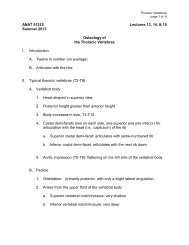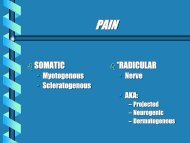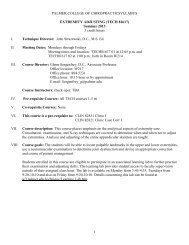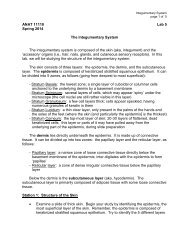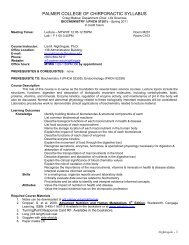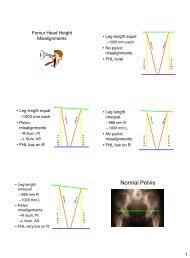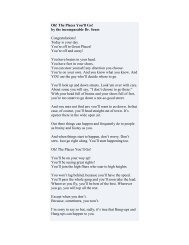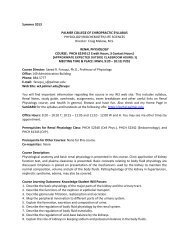Chemistry Review
Chemistry Review
Chemistry Review
You also want an ePaper? Increase the reach of your titles
YUMPU automatically turns print PDFs into web optimized ePapers that Google loves.
MOLECULAR BONDING Based on valence electrons and electronegativity Valence electrons – e - in outermost shellCHEMISTRY REVIEWLia M. Nightingale, Ph.D.Ca +FFCaBonded pairUnshared pairFFCaFUnpaired e -ORFCaFMOLECULAR BONDING Electronegativity – how easily an element can acceptelectronsMOLECULAR BONDING In a molecule:• Higher electronegativity = e - acceptor• Lower electronegativity = e - donator• Electronegativity difference (ΔEN) = Highest # – lowest #FCaFCa = 1.0F = 4.0ΔEN = 3.0MOLECULAR BONDINGΔENBond Type0 – 0.4 Nonpolar CovalentElectrons shared equally0.41 – 1.7 Polar Covalentδ+ δ-Electrons shared inequally≥1.8 Ionic+ -Electrons transferredMOLECULAR BONDING Nonpolar covalent bonds• HydrophobicHHCHHH = 2.1C = 2.5ΔEN = 0.41
OH HINTERMOLECULAR FORCES3. Hydrogen bonding• Type of dipole-dipole interaction between H & F, O, or NINTERMOLECULAR FORCES3. Hydrogen bondingEN:C = 2.5H = 2.1O = 3.51. H must be bonded to FON (H-bond donor)AND2. FON must contain an unshared pair of electrons(H-bond acceptor)HHCHHCHδ-OHδ+H-bonds are only 2-5% as strong as ionic bonds.Pure ethanol solutionINTERMOLECULAR FORCES3. Hydrogen bonding Compounds can be JUST H-bond acceptors• H-bond acceptor = double bonded oxygen will accept a HINTERMOLECULAR FORCES H-bonding is responsible for:• Holding DNA strands togetherINTERMOLECULAR FORCESINTERMOLECULAR FORCES4. Ion-dipole interactions• Between ionic compound and polar molecules• + ion is attracted to δ -• - ion is attracted to δ +• Strongest IMF – still a lot weaker than covalent or ionicbonds4. Ion-dipole interactionsOH HOH HOH HNa + Cl -3
StrengthSTRENGTH OF INTRA & IMFEX. PURE METHANOL SOLUTIONHHCHOHEN:C = 2.5H = 2.1O = 3.5EX. PURE ETHANE SOLUTIONEX. PURE LITHIUM FLUORIDE SOLIDHHCHHCHHEN:C = 2.5H = 2.1LiFEN:Li = 1.0F = 4.0What IMF are present if LiF is dissolved in water?INTERMOLECULAR FORCES Affect:• Melting point (mp)• Boiling point (bp)• Viscosity*More IMF means themore energy (heat)needed to put into thesolution to break the IMF.Compound MW(g/mol) bp( C)CH 3 OH 32 65CH 3 CH 3 30 -89LiF 26 1681WHAT ARE THE IMF?HHHCHHCHHCHOOHCHHHEN:C = 2.5H = 2.1O = 3.5Pure ethanol MW = 46.07 g/mol bp = __________°CPure dimethyl ether MW = 46.07 g/mol bp = __________ C4
PRACTICE: WHAT ARE THE IMF?ORGANIC VS. INORGANICOCH HMW = 30.03 g/molHH C FHMW = 34.03 g/molHOOMW = 30.02 g/molHEN:C = 2.5H = 2.1O = 3.5F = 4.0HOH 3 C Organic = contains hydrocarbon (C & H)• Ex. Lipids, carbohydrates, proteins, vitamins, flavorcompoundsCH 3CH 3OCH 2CH2CH 2CH2CH 2CH2CH 2CH2CH 2CH2CH 2CH2CH 3CH 3CH3 CH 3α-tocopherol (Vitamin E)CH 3ORGANIC VS. INORGANICIDENTIFY EACH MOLECULE AS ORGANIC OR INORGANIC. Inorganic = does NOT contain hydrocarbon• Ex. Minerals, ionic salts, phosphate ionsHHHSO 4HCCCOHNaAl• Ca(PO 4 ) 2 – fertilizerHHHSO 4• CaHPO 4 – baking powder• CaCO 3 – calcium supplement in TUMs• CaC 2 O 4 – causes kidney stones (oxalate)CH 3OH CH 3H 3 C C C CH 3H 3 C CH 3CH 3C LENGTHThe more carbons a molecule has, themore nonpolar it becomes (lesspolar).ORGANIC REVIEW Primary (1 )• Group of interest bound to C that is only attached to 1 otherCHHCHHCHOH5
ORGANIC REVIEW Secondary (2 )• Group of interest attached to C that is bound to 2 other CORGANIC REVIEW Tertiary (3 )• Group of interest attached to C that is bound to 3 other CHHCHCH 3C OHHHHCHCH 3C OHCH 3ORGANIC REVIEWORGANIC REVIEW AlcoholRest of the moleculeHCHOH AldehydeOCH Ex. Ethanol Ex. 3-methylbutanalHHCHHCHOHCH 3 OCHCCH 3CH 2HORGANIC REVIEW MethanalH EthanalH 3 COCOCHHCH 3 CHOORGANIC REVIEW1. Are aldehydes polar?2. What types of IMF can form in aldehyde solutions? HexanalCH 3 CH 2 CH 2 CH 2 CH 2OCH6
ORGANIC REVIEW KetoneOCORGANIC REVIEW1. Are ketones polar?2. What types of IMF can form in ketone solutions? Ex.Propanone ORAcetoneOH 3 CCCH 3ORGANIC REVIEWORGANIC REVIEW Carboxylic acidO Pentanoic acidOCOHCH 3 (CH 2 ) 3COH Ex. Acetic acidButyric acidCH 3 (CH 2 ) 3 COOHH 3 COCOHCHCH 3CH 2OCOHORGANIC REVIEW When acids are ionized replace –ic acid with -ateORGANIC REVIEW What types of IMF will solutions of acids form?H 3 COCOHAcetic acidOCH 3 CAcetateO -H 3 COCOH7
ORGANIC REVIEWCH 3ORGANIC REVIEWCH CH 2CHC3 (CH 2 ) 3 CH 2 OCCH 2 CH 3CH 2 O CH3Pentyl propanoateCH 3 OO Ester = acid + alcoholOCOCH 3 (CH 2 ) 3 CH 2 OH + CH 3 CH 2 COOH Ex. Isoamyl acetate3-methyl butyl ethanoatePentanolPropanoic acidH 2 OApricotORGANIC REVIEWCan a pure ester solution H-bond?OORGANIC REVIEW Other esters• Wax = long chain alcohol esterified to long chain fatty acid(FA)Contains an ester bond!CH 3 (CH 2 ) 3 CH 2 OCCH 2 CH 3• Triglyceride = FAs esterified to glycerolOO H 2 C O CR’ C O CH OH 2 C O CRR’’ORGANIC REVIEW Ether = reaction of 2 alcoholsORGANIC REVIEWCan a pure ether solution H-bond? Ex. Diethyl etherOH 3 COH 2 C CH2 CH 3H 3 COH 2 C CH2 CH 38
PRACTICE: LIST IMF FOR EACH COMPOUND DISSOLVED INWATER.ORGANIC REVIEWCH 3 CH 2 CH 2 OCH 2 CH 3CH 3 (CH 2 ) 3 CH 2 OHCompound IMF in Pure SolutionsHydrocarbon LDFAlcoholLDF, dipole-dipole, H-bondAldehydeLDF, dipole-dipoleKetoneLDF, dipole-dipoleCarboxylic acid LDF, dipole-dipole, H-bondEsterLDF, dipole-dipoleEtherLDF, dipole-dipoleCH 3 (CH 2 ) 3 CH 3ORGANIC REVIEWCompound IMF in Polar SolutionsHydrocarbon LDFAlcohol LDF, dipole-dipole, H-bond (A, D)AldehydeLDF, dipole-dipole, H-bond (A)Ketone LDF, dipole-dipole, H-bond (A)Carboxylic acid LDF, dipole-dipole, H-bond (2A, D)EsterLDF, dipole-dipole, H-bond (2A)EtherLDF, dipole-dipole, H-bond (A)A = H-bond acceptor; D = H-bond donorORGANIC REVIEW Amine – derivative of ammonia, where 1 or more H isreplaced with alkyl or aryl group3Ammonia 1 Amine 2 AmineNH 3 NH 2NH CHCH 3CH 33 AmineCH 4 Ammonium ion3H 3 C N CH 3+H 3 C N CHCH 33CH 3ORGANIC REVIEW All amines are polar & water-soluble Primary & secondary amines can H-bondREACTION MECHANISMS1. Oxidation – lose electron• Also called dehydrogenationN-H - - HO-H - - HEN:N = 3.0H = 2.1O = 3.51. LEO says GERLEO = Lose Electrons OxidationGER = Gain Electrons Reduction2. OIL RIGOIL = Oxidation Is LosingRIG = Reduction Is Gaining9
REACTION MECHANISMSSIDE NOTE: BREATHALYZER REACTION1. Oxidation – lose electronOHR C HH[Ox][Red]ORCH[Ox][Red]ORCOH1 Alcohol Aldehyde Carboxylic AcidOHH 3 C CH 2[K 2 Cr 2 O 7 ]Cr 3+OH 3 CCH[K 2 Cr 2 O 7 ]Cr 3+OH 3 CCOHEthanol Ethanal Ethanoic acidMeasure concentration by spectrophotometryREACTION MECHANISMS1. Oxidation – lose electronREACTION MECHANISMS1. Oxidation – lose electronOHR C R’H[Ox][Red]ORCR’2 Alcohol KetoneOHR C R’R’’[Ox]3 Alcohol No ReactionREACTION MECHANISMSREACTION MECHANISMS1. Oxidation reactions found in:• Metabolism• Formation of heart disease LDL oxidation• Cancer Oxidation of DNA can initiate cancer• Aging Oxidation can damage tissues & cause wrinkles2. Reduction – gain electrons• Hydrogenation reactionsROCOH[H]ROCH[H]ROHC HHCarboxylic AcidAldehyde1 Alcohol10
REDUCTION EXAMPLEREACTION MECHANISMS2. ReductionO[H]CH 3 (CH 2 ) 4 COHHexanoic AcidHexanalOCH 3 (CH 2 ) 4 CH[H]CH 3 (CH 2 ) 4 CH 2 OHHexanolROCR’[H]ROHC RHKetone2° AlcoholREACTION MECHANISMS1 & 2. Reduction & Oxidation = RedoxREACTION MECHANISMS1& 2. Reduction & Oxidation = RedoxAH 2 + B A + BH 2Lose e - /H Gain e - /HOxidized ReducedOHOH 3 C CH 2 + NAD + H 3 C CH + NADH + H +Lose e - /H Gain e - /HOxidized ReducedREACTION MECHANISMS3. Dehydration/Condensation Removal of waterREACTION MECHANISMS4. Hydrolysis – reaction with waterOHCH 3 CH 2 CH 2H 2 SO 4heatCH 3 CH CH 2Water is a product!!+ H 2 OOOCH 3 [HCO CH3+ H 2 O + ]CH 3 OH + HOCCH 3OHCH 3 CH 2+OHCH 2 CH 3H 2 SO 4heatH 3 COH 2 C CH2 CH 3Water is a reactant!!+ H 2 O11
REACTION MECHANISMS5. Methylation – addition of CH 3OHH 3 C CH 2CH 3 IO CH 3H 3 C CH 2 +HIMETHYLATION Important for DNA modifications & enzymemodifications• Can turn molecules ON or OFF Makes molecule less polarREACTION MECHANISMS6. Phosphorylation – adding phosphate(PO 32-)REACTION MECHANISMS6. Phosphorylation – adding phosphate(PO 32-)AdeninePhosphatesP P PAdenine +ribose =AdenosineHP PCH 2 OHOH HPATPPPADPHCH 2 OHPOHRiboseAdenosine triphosphate (ATP)Adenosine diphosphate (ADP)HOOHHHOHOHGlucoseHOOHHHOHOHGlucose-6-phosphateSIDE NOTE: PHOSPHORYLATION p53 tumor suppressor gene• Normally phosphorylated at 18 sites; controls subscription ofproteins that restrain cell division• When damaged and not phosphorylated, allows cancer togrow out of control• p53 gene not working in 90% of skin cancer & 50% of allother cancersREVIEW Identify the following functional groups:OCH CH 2 CCH 3 CH 2 CH 2 OH12
REVIEW Identify the following functional groups :REVIEW Identify the following functional groups :CH CH 2CH 3 CH 2CH CH 3OCH 3CH CH 2CH 2 OC CH2CH 3NH 2REVIEW Identify the following functional groups :REVIEW Identify the following functional groups :OHHHHOHHCCCCCOOHHOHOHCH 2 OHREVIEW Identify the following functional groups :REVIEW Identify the following functional groups :OHOHHCH 2 OHC OC HC OHC OHCH 2 OH13
REVIEW Identify the type of IMF each molecule would form in apure solution:REVIEW Identify the type of IMF each molecule would form in apure solution:OHREVIEW Identify the type of IMF each molecule would form:REVIEW Identify the types of reactions:*If redox, identify molecule reduced and compound oxidized.K Cl + H 2 OHOHHCH 2 OHPC OC HCCOHOHCH 2 OPPPATPPPADPHOHHCH 2 OC OC HCCOHOHCH 2 OPPFructose-6-phosphateFructose-1,6-bisphosphateREVIEWREVIEW Identify the types of reactions:*If redox, identify molecule reduced and compound oxidized.CH 3CH 2CHCHCH 2CH 3+ H 2 OCH 3CH 2CH 2CH 2CH 2CH 3 Identify the types of reactions:*If redox, identify molecule reduced and compound oxidized.HHHOHHCCCCCOOHHOHOHCH 2 OHCH 3 IHHHOHHCCCCCOOHHOHOHCH 2 OCH 3+ HI14
REVIEWREVIEW Identify the types of reactions:*If redox, identify molecule reduced and compound oxidized. Identify the types of reactions:*If redox, identify molecule reduced and compound oxidized.HOHOHOCOHCOHOHHOO2Fe 3+ 2Fe 2+OOHHOHOOOO+ 2HHHOHHCCCCOHHOHOHHHOHHCCCCOHHOHOH+ H 2 OCH 2 OHCH 2 OHSUMMARY You should be able to:• Identify bonding types• Identify IMF• Determine whether a molecule is organic or inorganic• Draw basic organic structures• Recognize the main reaction mechanismsREFERENCES1. Brown. 1997. Introduction to Organic <strong>Chemistry</strong>.Saunders College Publishing.2. Nelson. 2000. Lehninger: Principles of Biochemistry,Third Edition. Worth Publishers.3. Boyer. 1999. Concepts in Biochemistry. Brooks/ColePublishing.15



